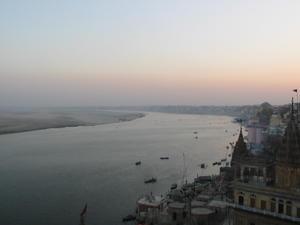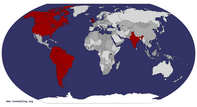Advertisement
Published: February 25th 2006

 Varansai - Feb. 19, 2006
Varansai - Feb. 19, 2006
Sunset - view from our balcony our first night in Varansai This city of 1.5 million is situated on the River Ganges where, over a 7 kilometre bend, it turns north west, and then south east, for its final flow, about 500 miles to the Bay of Bengal. Varanasi, where the two rivers, Varna and Assi, meet the Ganges, is some 475 miles south east of Delhi, the national capital.
As a city-site, it is old, really old; arguably the oldest continuous city- site known; the Aryans were here as early as 1000 BC. It is also Hinduism's most sacred site. All three of Hinduism’s Trinity, Brahma, Vishnu and Shiva are said to have performed rites here. Mama Ganga, as the river is known, played an integral role in all of these rites, the foundation of her own holy status.
About a million pilgrims come to this city every year. From our hotel room, we could see them arrive, from as early as 4am, one morning, to as late as 1am, the next. They say a communal prayer, take a communal bath in the Ganges, then sit lotus style and meditate in Yoga. It is said that anyone, who dies in the sacred cartier of Varanasi, goes directly to heaven,

 Varansai - Feb. 20
Varansai - Feb. 20
Sunrise - view from boat his good karma quotient in surplus.
This city has a high density of religious buildings per square kilometre. In the seven kilometre stretch of river, for two kilometres back from the water, there are about 1000 active, religious buildings.
In order to get from the railway station to the riverside, where our hotel is situated, we needed to go through the new city, fair enough; but into the entrails of the old city, a whole different century in time and place. Wisely, our host sent one of his employees to fetch us, in an auto rickshaw. He was to guide us through the maze of narrow lanes and single-file footpaths that bob and weave their collective ways to the riverside. People live along the footpaths; the lanes are lined, cheek to jowl, with every small business activity imaginable. The bowels of the old city are in-accessible to any vehicle with more than two wheels; but are the domain of any creature, with or without legs; living or dead. Bicycles, motorbikes, cows, dogs, pedestrians, amputees and corpses on stretchers, carried by the wailing bereaved, jostle for advanced positioning. At times, I was having trouble finding myself, never mind Penny,
or our trusty guide; but he could find us, lucky thing. We discovered, on subsequent excursions through the maze, that its by-ways are relatively clean at say 7am. However, on this first walk through, every disposable item was on the walking surface, including fresh cow patties. They are collected, dried and used, we are told, as mortar for buildings and as a heat producing substance. We would never have found our hotel without the good graces of our employee-guide.
We got to our hotel, settled in, sipped the remaining brandy, leftover from one of our Darjeeling wisemen; and put the experience of the old city labyrinth into perspective. On sober, we think, reflection, we agreed we just had to have the exposure. This, after all, was India at its rawest real, prompting: "get real too; deal with all that you encounter; or renege, and be short on the fullness of your experiential account."
We decided we would walk the riverside to get a sense of what happens there. From the water level, the western shore rises to where temples, shrines, palaces and other buildings stand. Access to the riverside, from these structures, is by steps, called ghats, about
one hundred or so on each compound. There are about a hundred of these properties along the riverside. To traverse them is to visit the Ghats of Varanasi. At the riverside, before each of these properties, there are structures, octagonal, circular, square, where pilgrims do their meditation after ritual baths in the river.
All ghats honour Shiva with a shaft of stone, a linga; and was either built to a theme, or erected by one of India's ruling families, as their way of being at the Ganges; just like the heavy stream of everyday pilgrims, who seek blessings here; but are not able to build a palace in wait. Many of the palatial ghats have become functional in an everyday manner, the ruling families having declined in prominence as democracy emerged.
We stayed at the Scindia Ghat, where a temple to Shiva leans, having suffered the ravages of time and weight on its foundations.
Next to Scindia, going south, is the Manikarnika Ghat, the burning ghat , main cremation site of Varanasi, operational all day, all night. On this walk by, we stood and watched briefly; we had to. Aside from ritual, these are human moments, magnified

 Varansai - Feb 20
Varansai - Feb 20
The Ganges is filled with boats each morning for sunrisewhen ten pyres are alight simultaneously. I stood, empathizing in spirit with the families of the departeds. I could not help but consider how different, and yet how similar, were the beliefs, that they and I brought to this rite. They; birth, life, death; multi-incarnations, aspiring to divine existence. I; birth, life, death; single-incarnation, aspiring to divine existence. Millimeters of difference; shades of sameness.
Associated with the Manikarnika Ghat is the Manikarnika Kund or pond, said to be the world's first sacred place, according to Hindu beliefs, created by Vishnu, the preserver in the Hindu Trinity.
At the Dhobi Ghat, further south, laundry is done by the method of beating the clothes on concrete, after they have been purified, so goes the ledged, by their soak in the Ganges.
Incidentally, we did happen upon a Panday Ghat. It is said to be in memory of certain rites performed there by Brahma.
The Munshi Ghat hosts Varanasi Muslims, 14% of the population, when they attend the river.
Many ghats now serve a myriad of activities: restaurants, at one of which we had lunch; hotels a-plenty; yoga and music schools abounding; cows, each one sacred, taking baths;
weddings, brides attached to their grooms by silken bands; a water purification plant; silk factories producing the material for which Varanasi is renowned; children and adults flying kites; touts, purveying heaven knows what; I took to answering their entreaties en Francais; it got rid of them, heads shaking. We held further exploration until our evening at the river; this time, by row boat for two.
The city scape, looking west from the river at dusk, is a truly impressive sight, a bold expression of religiosity. Along with hundreds of others in boats, we place Minatare flames, with tender flowers, in delicate dry leaves, to drift with the river flow. The river is aglow, soothing chants echo from the river bank, religious forms loom in the sky and a reluctant sun dissipates, as a great, puff ball of pristine, white cotton fuzz. Together, they create an indelible vignette; we shall remember it for much time to come.
The Dashaswamedh Ghat is where the Ganga Fire Arti takes place in the early evening. Priests lead assembled thousands in ancient prayer rituals, supported by a wall of sound, from conch shells, drums and bells. But the ceremonies begin in earnest, only

 Varansai - Feb. 21
Varansai - Feb. 21
Alleyway - early in the day before the debris accumulatedafter sweet utterings of the holiest of sounds, that of the OM sound, associated with creation of the universe, according to Eastern religions. The rituals are performed from seven alters, each candle-lit and bedecked in scarlet and gold. A choir chimes in with songs of praise, swaying to the rhythms of their music. Seven acolytes, in white garb bound by sashes, brown, red, green and blue, are in perpetual, performance motion. They continually turn fully clockwise from east, while articulating fire spewing ornamental instruments, at knee, waist, head and over-head level. This goes non stop for an hour, inducing either charisma or catharsis, I did not tarry to discern which. As the performance and its witnesses reached for a life of their own, the head priest commanded a rousing set of anthems from his choir. Then, with the assembly at high emotional pitch, he mercifully bestows a final blessing to the congregation and offers a cascade of flowers to Mama Ganga. The celebration tones down and fades out, as we slip away in our row boat, into the embracing arms of the dark.
Our morning boat ride casts off in the dark of the early day; birds tweeting, people

 Varansai - Feb 22
Varansai - Feb 22
Sunrise - view from our balcony our last morning in Varansaisplashing through their morning baths, past Meer Ghat for widows, a stream of early supplicants going to temple, bells chiming. The sky shows streaks of embering planks, lateral to the shore, with upward streaking sun rays, no sun, imparting a soft pink veneer.
Early morning on the Ganges seems like a time when people quietly go about their individual ways. Their activities have an extemporaneous un-rehearsed air about them. There are no authority figures out here; just simple people, doing simple, devotional, spiritual things. Except for the sun looking to rise, the only integrative element is soft chanting, wafting to us over the water, " Hari Krishna, Hari Krishna, Hari Krishna; Hari, Hari... Hari Har Har, Hari Har Har, Hari Har Har; Hari, Hari."
The sky goes imperceptibly, progressively, from dark to blue; the embering planks, we saw earlier, are embered, burned to faint ash; thus far, it seems, we are party a dawning of the day, not a rising of the sun. And then, lo and behold, it magically manifests itself, becomes, is, whole, red. It hovers, low to the water, miraging the intervening, eastern landscape out of existence. Then, it climbs, inserting a pillar of red into the water; and sits there glowing, morphing from bold red to active white; and blazes the day into action.
We went home, pensive, humbled; had a simple breakfast of tea and coffee, orange juice, bananas and toast. Fed, we left by auto rickshaw for Saranath, where the first of the Buddha’s preached his first sermon, several centuries, BC.
Advertisement
Tot: 0.153s; Tpl: 0.015s; cc: 14; qc: 65; dbt: 0.0755s; 1; m:domysql w:travelblog (10.17.0.13); sld: 1;
; mem: 1.2mb









